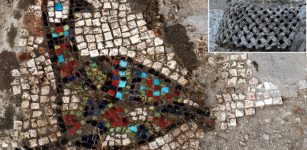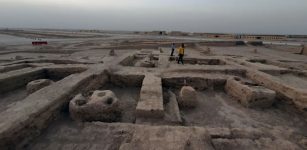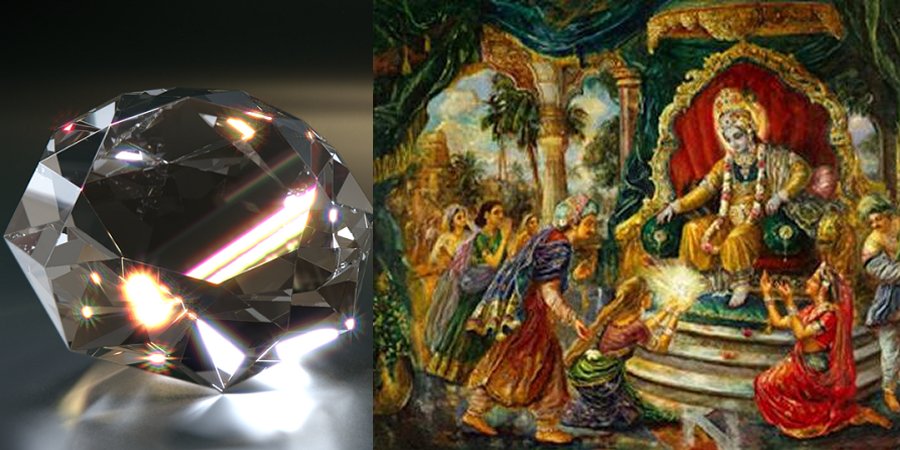Syamantaka – Divine Jewel With Magical Powers Was A Gift From The Sun God In Hindu Mythology
Ellen Lloyd - AncientPages.com - Whether it is a ring, necklace, cup, stone, or some other object, precious artifacts with supernatural abilities are often mentioned in myths and legends of our ancestors.
Syamantaka was a divine gem with magical abilities in Hindu mythology. Tradition has it that the land in possession of Syamantaka was protected from droughts, floods, earthquakes, and famines.
Left: Diamond. Credit: Public Domain - Right: Lord Krishna receives the Syamantaka. Credit: Jagannath Puri Hare Krishna Movement
This precious jewel could provide gold daily.
Syamantaka, The Most Famous Jewel In Hindu Mythology
Syamantaka, the most famous jewel in Hindu mythology, originally belonged to the Sun god, who wore it around his neck.
As the legend goes, Satrajit, a nobleman from Dwarka who was a great devotee of Surya, the Sun God, decided he would perform a rigorous penance to appease the Sun God. He left all his possessions and went to live in the forest, where he stayed for many years.
As Ahalya Gautam writes in the book Popular Upanishads Tales For All, one day, "the Sun god appeared before him and made him visit his abode. Finally, the happy Lord gave Satrajit his much renowned and fabled Syamantaka Mani (the gem). Satrajit wore that gem around his neck and returned to Dwarka. Owing to his wearing that gem, his whole personality dazzled like the sun."
An exciting part of the story concerns what the Sun God looked like after removing the jewel from his neck. According to the legend, the Sun God was shining so brightly that Satrajit couldn't see him. He asked the deity to appear in a less fiery shape. When the Sun God removed the Syamantaka jewel off his neck, Satrajit could see that his worship deity was not very tall. The Sun God had dwarfish stature, with a body like burnished copper, and his eyes very slightly reddish eyes.
With the precious jewel hanging around his neck, Satrajit returned to his palace. Now he was also shining brightly, and the guards mistook him for the Sun God.
They quickly notified Lord Krishna that the Sun God had taken his place in Dwarka. When Lord Krishna learned about this, he smiled and said: "He is not the Sun god but only our brethren Satrajit. His body is appearing so sparkling because he is wearing the fabled gem Syamantaka. The gem creates this impression around the wearer's personality."
Lord Krishna Accused Of Murder And Theft
Satrajit placed the precious jewel in his palace on a unique altar; each day, the stone produced plenty of gold.
Satrajit and Prasena with the Symantaka Mani, an Illustration to the Bhagavata Purana Credit: Public Domain
One day Lord Krishna told Satrajit that he should give the magical stone to the King of the Yadus, Ugrasena, but Satrajit refused. The magnificent Syamantaka turned Dwarka into a prosperous and peaceful kingdom free from diseases and distress.
Not long after this, Satrajit's brother Prasena went hunting, and he had the Syamantaka hanging on a chain around his neck. Prasena was killed by a lion that took the jewel to a cave in the mountains. The cave inhabitants were Jambavan, the King of the Bears, and one of the Chiranjeevi, the seven immortals in Hinduism who are to remain alive on Earth until the end of the current Kali Yuga.
Rumors spread, and it was believed that Lord Krishna had stolen the precious Syamantaka. Satrajit was worried that his brother had not returned, and he suspected Lord Krishna had murdered Prasena.
"Not only had Krishna also expressed the desire of possessing that gem. The recollection of that desire of Krishna convinced Satrajit that Krishna had murdered Prasena to possess that gem. When this rumor spread far and wide in Dwarika (Dwarka), people started looking at Krishna with a suspicious eye," Ahalya Gautam writes.
Lord Krishna was innocent, and the only way to prove this was to find the magical gem. He went to the forest, followed the trail of the deceased Prasena, found the man's body, and finally located the mountain cave where he saw the dead body of the lion. Lord Krishna noticed tracks of a bear inside the cave and followed them. Then, he saw how Jambavan's children were playing with the valuable jewel. Lord Krishna engaged in a furious battle with Jambavan, the King of the Bears.
When Lord Krishna did not return to Dwarka, his father Vasudeva was sorrowful, but the divine seer Narada offered comforting words to all the people of Dwarka.
"You should not weep as Krishna cannot be slain. However, to ensure his safety and welfare, they should also hymn the praises of Mother Ambika, who would surely bring him back safely," Narada said.
The battle between Lord Krishna and Jambavan lasted 28 days until the King of the Bears finally grew tired. Lord Krishna took the precious gem, returned it to Dwarka, and gave the stone to Satrajit, who accepted the jewel but with great shame and remorse.
Satrajit felt bad. He had accused Lord Krishna of murder and theft. So, he decided to offer Lord Krishna the jewel and his three daughters, Satyabhama, Vratini, and Prasvapini.
Lord Krishna accepted the hand of Satrajit's daughter, Satyabhama, but he had no interest in the jewel.
Not long after this, Lord Krishna left Dwarka and thieves used this opportunity to steal the precious gem. They broke into Satrajit's palace, killed him, and stole the Syamantaka. When Lord Krishna learned about this crime, he was furious. He traveled back to Dwaraka to avenge Satrajit's death.
Lord Krishna chased down Kritavarma, Akrura, and Satadhanwa, who were the thieves. Akrura, chief of the Yadavas, an ancient people of India, managed to escape with the jewel to Kashi.
Lord Krishna summoned Akrura and asked him to admit his guilt. When Akrura complied, Krishna let him keep Syamantaka on the condition that it would remain in the city of Dwaraka.
Was Syamantaka A Real Jewel?
Since the fate of Syamantaka is unknown, many have speculated whether the precious stone was more than just a mythological jewel. Dwarka was long considered a mythical place, but this changed when underwater archaeologists discovered the ancient ruins of Krishna's kingdom on the coast of Gujarat, just near the Pakistan border.
Could the Syamantaka still lie at the bottom of the ocean?
Some have suggested Syamantaka was the famous Koh-i-Noor diamond, known to have been owned by the Mughal emperors of India and, at present, is one of the Crown Jewels of England.
"It was only really in the early nineteenth century, when the Koh-i-Noor reached Punjab and the hands of Ranjit Singh, that the diamond began to achieve its pre-eminent fame and celebrity – so much so that by the end of Ranjit's reign, pious Hindus were beginning to wonder if the Koh-i-Noor was the legendary Syamantaka gem mentioned in the Bhagavad Purana's tales of Krishna," Anita Anand and William Dalrymple wrote in the book Koh-I-Noor: The History of the World's Most Infamous Diamond.
Whether Syamantaka was just a magnificent mythological artifact or a natural, precious jewel is still debated.
Updated on June 10, 2024
Written by Ellen Lloyd – AncientPages.com
Copyright © AncientPages.com All rights reserved. This material may not be published, broadcast, rewritten or redistributed in whole or part without the express written permission of AncientPages.com
Expand for referencesMore From Ancient Pages
-
 Why Winter Solstice Matters Around The World
Archaeoastronomy | Dec 20, 2022
Why Winter Solstice Matters Around The World
Archaeoastronomy | Dec 20, 2022 -
 Legendary Uchchaihshravas: Divine Seven-Headed Flying Horse Of God Indra
Featured Stories | May 1, 2017
Legendary Uchchaihshravas: Divine Seven-Headed Flying Horse Of God Indra
Featured Stories | May 1, 2017 -
 Unexpected Archaeological Discovery May Re-Write English Civil War History
Archaeology | Feb 3, 2023
Unexpected Archaeological Discovery May Re-Write English Civil War History
Archaeology | Feb 3, 2023 -
 Before Ragnarok: Horrifying Fimbulwinter In Norse Mythology Was Based On Real Events
Featured Stories | Nov 1, 2016
Before Ragnarok: Horrifying Fimbulwinter In Norse Mythology Was Based On Real Events
Featured Stories | Nov 1, 2016 -
 Frightening Ancient Underground World Discovered In Tibet – Evidence Of A Lost Advanced Civilization?
Featured Stories | Feb 17, 2024
Frightening Ancient Underground World Discovered In Tibet – Evidence Of A Lost Advanced Civilization?
Featured Stories | Feb 17, 2024 -
 Ancient Roman Government Structure And The Twelve Tables
Civilizations | Jan 18, 2016
Ancient Roman Government Structure And The Twelve Tables
Civilizations | Jan 18, 2016 -
 Garamantes: 3,000-Year-Old Sophisticated North African Society Built 3,000-Mile Network Of Underground Irrigation Canals
Featured Stories | Jan 29, 2022
Garamantes: 3,000-Year-Old Sophisticated North African Society Built 3,000-Mile Network Of Underground Irrigation Canals
Featured Stories | Jan 29, 2022 -
 Danish Royal Sunken Ship Sheds Light On Psychological Warfare In The Middle Ages
Archaeology | Apr 3, 2017
Danish Royal Sunken Ship Sheds Light On Psychological Warfare In The Middle Ages
Archaeology | Apr 3, 2017 -
 Strange Tuxtla Statuette And Its Undeciphered Inscription – An Epi-Olmec Puzzle
Artifacts | Mar 14, 2018
Strange Tuxtla Statuette And Its Undeciphered Inscription – An Epi-Olmec Puzzle
Artifacts | Mar 14, 2018 -
 Trajan’s Market Was The World’s First Known Shopping Mall
Ancient History Facts | Jul 2, 2016
Trajan’s Market Was The World’s First Known Shopping Mall
Ancient History Facts | Jul 2, 2016 -
 St. Simeon’s Monastery And History Of Its Founder Shed Light On Christian Past In Anatolia
Archaeology | Nov 28, 2020
St. Simeon’s Monastery And History Of Its Founder Shed Light On Christian Past In Anatolia
Archaeology | Nov 28, 2020 -
 Lost Treasure Of King Atterdag Remains An Unsolved Ancient Mystery
Featured Stories | Jul 13, 2017
Lost Treasure Of King Atterdag Remains An Unsolved Ancient Mystery
Featured Stories | Jul 13, 2017 -
 Unique Balchiria Stelae Engraved With A Goat-Like Figure Found On Corsica Is A Puzzle
Featured Stories | Feb 3, 2020
Unique Balchiria Stelae Engraved With A Goat-Like Figure Found On Corsica Is A Puzzle
Featured Stories | Feb 3, 2020 -
 Shrine Discovered In Egyptian Temple And Evidence Of Previously Unknown Rituals
Archaeology | Oct 6, 2022
Shrine Discovered In Egyptian Temple And Evidence Of Previously Unknown Rituals
Archaeology | Oct 6, 2022 -
 Ancient Parthian City With Hundreds Of Artifacts Unearthed In Iraq
Archaeology | Aug 16, 2022
Ancient Parthian City With Hundreds Of Artifacts Unearthed In Iraq
Archaeology | Aug 16, 2022 -
 Tooth Enamel Reveals Life Histories Of Early Humans
Archaeology | Jan 16, 2023
Tooth Enamel Reveals Life Histories Of Early Humans
Archaeology | Jan 16, 2023 -
 Kudurru Of Melishihu – Stone Records From The Kassite Dynasty In Babylonia
Artifacts | Jan 17, 2016
Kudurru Of Melishihu – Stone Records From The Kassite Dynasty In Babylonia
Artifacts | Jan 17, 2016 -
 Restorations At Stratonicea Ancient City Of Gladiators In Turkish Muğla Province
Archaeology | May 10, 2023
Restorations At Stratonicea Ancient City Of Gladiators In Turkish Muğla Province
Archaeology | May 10, 2023 -
 Rare Discovery: Remains Of An Avar Warrior And A Belt Unearthed In Vinkovci, Croatia
Archaeology | May 3, 2020
Rare Discovery: Remains Of An Avar Warrior And A Belt Unearthed In Vinkovci, Croatia
Archaeology | May 3, 2020 -
 Legacy Of The Iconic Sycamore Gap Tree – Historical Landmark At Hadrian’s Wall
Featured Stories | Mar 28, 2024
Legacy Of The Iconic Sycamore Gap Tree – Historical Landmark At Hadrian’s Wall
Featured Stories | Mar 28, 2024


